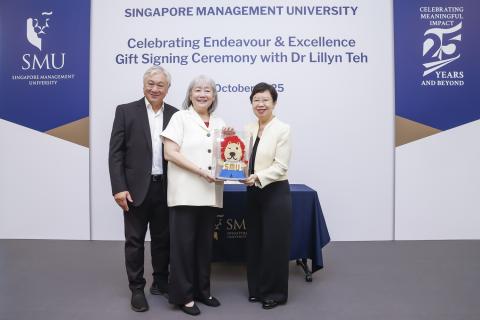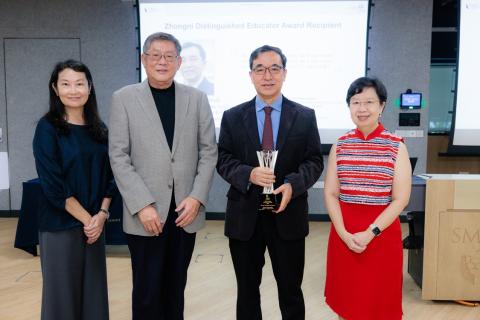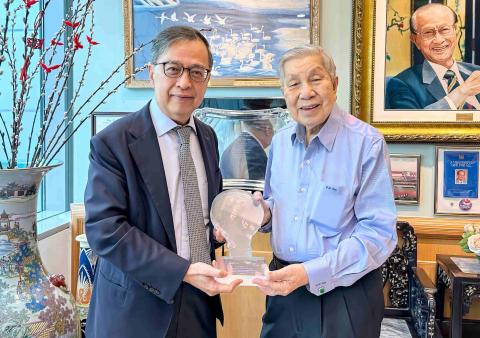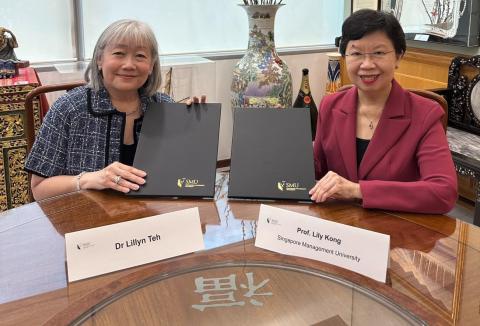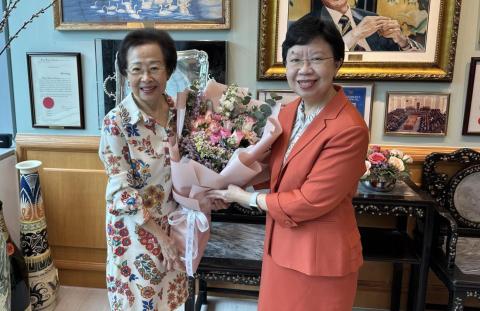Singapore Management University launches exhibition and first ever publication on artist Chua Ek Kay's Street Scenes
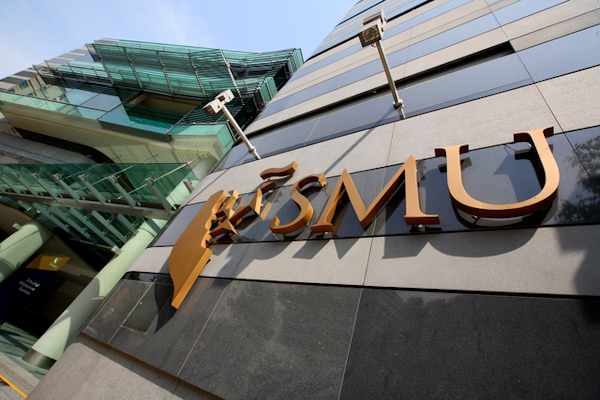
The Singapore Management University (SMU) is proud to present Chua Ek Kay's Street Scenes: A Gift of History, an exhibition of rare works by the distinguished contemporary ink artist and Cultural Medallion recipient, Chua Ek Kay. The exhibition opens today and features 20 works from Chua's Singapore Street Scenes series in the SMU Collection, including his earliest 1986 and most recent 2006 works.
Spanning two decades of his artistic practice, the works depict old shop houses, narrow alleyways, historic sites and other memories in the city. They invoke nostalgia and pay tribute to Singapore's history and heritage through Chua's distinctive style. The exhibition surveys Chua's development of the theme, reflecting the impact of Singapore's changing urban landscape on the artist's sense of history and identity, as well as presents a summation of the processes of Chua's formal artistic maturity.
The works exhibited are selected from 30 works donated by Chua to the Singapore Management University Collection in October 2006. His Street Scenes capture many of the artist's haunts in the Bras Basah, Little India and Chinatown districts, and have found a fitting home in SMU, given its location at the heart and in close proximity to these districts. Valued at over S$300,000, the works are permanently housed in the Lee Kong Chian School of Business and are presented in a public exhibition for the first time.
To recognise Chua for his generous donation, SMU has also published a monograph, entitled Chua Ek Kay: Singapore Street Scenes, Evoking Memories. The first publication to be produced on his monumental Singapore Street Scenes, the book contains insightful essays by some of Singapore's noted commentators and historians: Joanna Lee, Gretchen Liu, Kwok Kian Chow and T.K. Sabapathy. The essays bring readers through Chua's artistic development over three decades and the evolution of his Street Scenes series. They also look at the influences of the changing landscapes and memories shaped by Singapore's housing development and Chinese ink painting traditions on Chua's style, and include critical reviews of his works.
The exhibition and publication of Chua and his works is part of SMU's Visual Arts Initiative. The Initiative seeks to build an institutional collection of contemporary art with a focus on Southeast Asian art, and also develop and host art exhibitions and enrichment programmes to enrich and enliven the SMU campus experience for students and the general public.
“As a relatively new resident in Singapore's historic Bras Basah district, Singapore Management University is mindful of the area's vibrant heritage as a bustling civic centre and hub of trade. It was here that the seeds were laid for Singapore to prosper into the dynamic, modern city it is today. With the receipt of Ek Kay's generous gift of the collection, the university assumes the responsibility to ensure that generations of people in Singapore have the opportunity to appreciate this piece of cultural heritage. I am honoured that SMU is able to play a role in sharing Ek Kay's invaluable trace of our city's social history, both through providing a permanent home for his Street Scenes collection and with the publication,” said Professor Howard Hunter, President of SMU.
The exhibition is curated by Joanna Lee and is at The Gallery at the School of Economics / School of Social Sciences in SMU until 12 September (daily 10am-8pm). It is part of the Singapore Art Show, organized by the National Arts Council. The publication retails at $59.90 (including GST) at all leading book stores in Singapore.
About Chua Ek Kay
Chua Ek Kay is one of Singapore's foremost artists. Born in 1947 in Guangdong province, China, he migrated to Singapore when he was five years old. Chua came to the decision to devote himself to art making relatively late in life in 1987. Once his decision was made, he pursued it with single-minded devotion. At the prime of his life, he returned to being a student, first at LaSalle College of the Arts, then to Australia for a Bachelor's degree at the University of Tasmania in 1994, and a Master's degree at the University of Western Sydney the following year. Chua has received a number of eminent art awards and accolades, and made tremendous contributions to developing the local arts scene as artist, educator, judge, advisor and mentor. In the ultimate recognition to his esteemed achievements and contributions to developing Singapore's artistic standing, he was conferred the prestigious Cultural Medallion by the Singapore government in 1999.
About the writers
Joanna Lee is an independent art curator and writer with a special focus on Southeast Asian art. She is currently artistic director of Wheelock Art Gallery, Singapore and is also editor of the publication. Her essay traces Chua's artistic development which spans three decades, exploring his foundations in both the Chinese ink tradition and Western art. It moves on to examine Chua's Singapore Street Scene series, a theme which the artist returns to throughout his practice, as well as his contemporary re-interpretation of traditional landscape painting through the natural realm.
Gretchen Liu is an accomplished author of more than one dozen illustrated landmark books on the history and heritage of Singapore . She brings readers on a historical journey of housing development and its shaping of social and physical identities in Singapore to provide the context of the changing landscapes and memories that Chua has captured in his Streets Scene series.
Kwok Kian Chow is the founding director of the Singapore Art Museum, author of several books on the development of modern art in Singapore and Southeast Asian, and also recipient of France's Chevalier de l'Ordre des Arts et des Lettres in 2002. His essay looks at Chinese ink painting, the evolution of the xieyi (writing the idea) aesthetic and how Chua has skillfully applied its conceptual aesthetics in contemporary art.
T. K. Sabapathy is an art historian who has researched and published extensively on art in Southeast Asia, providing important foundations for the study of art in the region. He contributed four essays – three critical reviews previously published in Chua's solo exhibition catalogues, and one commissioned article for the publication which examines the different interpretations of Chua's practice between the artist himself and art historians.

